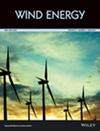风力涡轮机控制和协同设计的最佳工作点
IF 3.3
3区 工程技术
Q3 ENERGY & FUELS
引用次数: 0
摘要
本文介绍了一个多功能框架,用于确定风力涡轮机控制的最佳稳态工作点。该框架以解决固定风速下的约束优化问题为基础,可以系统地研究所需的权衡和参数敏感性。该框架可作为多种控制方法的基础,例如,自动计算控制输入的最佳时间表、模型线性化的稳态工作点或跟踪参考值。稳态仿真结果采用全非线性模型,以考虑空气动力学、结构动力学以及浮动风力涡轮机的流体动力学耦合造成的复杂影响。由于只关注稳态响应,因此可以快速进行数值稳健优化,这对协同设计研究特别有吸引力。该框架的有效性已在两台海上极端规模风力涡轮机(一台浮动,一台固定底部)上得到验证。本文章由计算机程序翻译,如有差异,请以英文原文为准。
Optimal operating points for wind turbine control and co‐design
A versatile framework is introduced for determining optimal steady‐state operating points for wind turbine control. The framework is based on solving constrained optimization problems at fixed wind speeds and allows for systematically studying required trade‐offs and parameter sensitivities. It can be used as a basis for many control approaches, for example, to automatically compute optimal schedules for control inputs, steady‐state operating points for model linearization, or reference values for tracking. Steady‐state simulation results are obtained using full nonlinear models to consider complex effects caused by couplings from aerodynamics, structural dynamics, and possibly also hydrodynamics in the case of floating wind turbines. Focusing only on the steady‐state response allows a fast and numerically robust optimization, which makes it especially attractive for co‐design studies. The effectiveness of the framework is demonstrated on two offshore extreme‐scale wind turbines, one floating and one fixed bottom.
求助全文
通过发布文献求助,成功后即可免费获取论文全文。
去求助
来源期刊

Wind Energy
工程技术-工程:机械
CiteScore
9.60
自引率
7.30%
发文量
0
审稿时长
6 months
期刊介绍:
Wind Energy offers a major forum for the reporting of advances in this rapidly developing technology with the goal of realising the world-wide potential to harness clean energy from land-based and offshore wind. The journal aims to reach all those with an interest in this field from academic research, industrial development through to applications, including individual wind turbines and components, wind farms and integration of wind power plants. Contributions across the spectrum of scientific and engineering disciplines concerned with the advancement of wind power capture, conversion, integration and utilisation technologies are essential features of the journal.
 求助内容:
求助内容: 应助结果提醒方式:
应助结果提醒方式:


